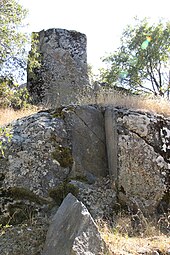Karakız Quarry
The quarry and the sculptor's workshop in the central Turkish town of Karakız probably date from the time of the Hittite Empire in the late 2nd millennium BC. Chr.
location
The site is located in the vicinity of Karakız in the Sorgun district of the central Turkish province of Yozgat , about 15 kilometers east of the district town. It is located about 70 kilometers southeast of the capital Hattuša , in the Halysbogen , the heartland of the Hittite Empire. The numerous traces of quarrying and sculpting work are spread over a wide area in the north and south of the town as well as in the eastern valley of Hapis Boğazı , through which a stream flows to Çekerek Çayı . The area extends for 2.5 kilometers from northeast to southwest and about a kilometer in the other direction. The pending granite forms by slow erosion protruding blocks and formations that erupt through the topsoil. They show extensive traces of processing.
Unique pieces
In the village of Karakız, north of the center ( 39 ° 48 ′ 28 ″ N , 35 ° 21 ′ 13 ″ E ), a double lion base was found, of which the left animal has been largely preserved. A fragment of the right lion showing the front legs was preserved. The broken side of the main fragment has a hole in which treasure hunters apparently placed dynamite to separate the two animals. The monument is about two meters long, the greatest height is 1.80 meters, the original total width must also have been 1.80 meters. The total weight is estimated at five tons. The body of the moving animal is very naturalistic, so that it can be assumed that the sculptor was able to observe living lions. The shapes and the edges are rounded, which is typical for the use of the stone hammers used by Hittite artists. Both front legs are stretched forward. Viewed from the side, four more legs can be seen in the relief in a creeping position. The right front leg is shown twice. By stretching out the left front paw, the artist still manages that only four legs can be seen from almost every angle. Depending on the point of view, the outstretched paw covers the surplus fifth leg. The tail winds behind the hind leg around the corner onto the back of the block. Only eyes and ears can be seen of the head, the front of the face is only present as a flat surface. The two animals stood on a common base plate in the shape of an oval cut off at the back. An irregular, roughly rectangular block rises above the back. Whether it should carry a statue, a pillar or something else cannot be decided. There are no dowel holes.
A second pair of lions can be found about 2.7 kilometers northwest of the first specimen in the valley of Hapis Boğazı ( 39 ° 49 ′ 15 ″ N , 35 ° 22 ′ 47 ″ E ), on a terrace about eight meters above the river bed on its east side. This is also broken into two main parts, some of which are still in the ground. The upper right lion is easy to see and shows strong similarities to the Karakız lion described above. The base plate, back plate and processing of the monument also show only minor differences.
Various unfinished objects were discovered in the area south of the village. These include a rectangular block, a water basin, a round vessel, a piece of an architectural frieze, and a cylindrical fragment that his excavators believe is an unfinished statue.
Dating and interpretation
A stone hammer fragment was found at both lion bases and in the south of the village. These tools, which were common in Hittite times, together with the type of processing, lead to the dating of the site to the second half of the 2nd millennium BC. It cannot be clarified for which place the artifacts produced here were intended. Since the quarries and workshops for equipping sanctuaries were generally no more than five to six kilometers from the destination at this time, none of the known places is an option. In the north of Karakız, at a place called Çatal Çeşme with abundant springs, lies a Byzantine settlement, where ceramics and kilns were found. The archaeologist Geoffrey D. Summers , who first explored the site, believes it is possible that it was the site of a Hittite sanctuary that was built over in Byzantine times.
exploration
In 2001, the local Kamil Sedat Uyar made the then director of the Yozgat Museum, Erol Özen, aware of the site. In the same year a team from the excavation in Kerkenes visited the site. This was followed by an extensive survey of the surrounding area by Summers and Özen. İlknur Taş and Özlem Sir Gavaz from Hitit Üniversitesi in Çorum carried out further investigations and excavations with Ömer Yılmaz from the museum in Yozgat.
Web links
literature
- Geoffrey D. Summers, Erol Özen: Field Report: The Hittite Stone and Sculpture Quarry at Karakız Kasabası and Hapis Boğazı in the District of Sorgun, Yozgat, Central Anatolia In: American Journal of Archeology 116 (2012). Pp. 507-519
- İlknur Taş, Ömer Yılmaz, Özlem Sir Gavaz: Identification of an Unfinished Statue Found in a Quarry at Karakız, Sorgun, Yozgat In: L. Feliu, J. Llop, A. Millet-Albà, J. Sanmartín (eds.): Time and History in the Ancient Near East Eisenbrauns 2013 pp. 833–837




